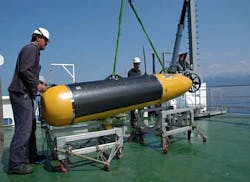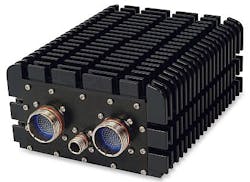NATO minehunting UUV relies on GPU-based embedded processor from GE for imaging sonar
HUNTSVILLE, Ala., 24 March 2013. NATO military technology researchers needed real-time digital signal processing (DSP) capability for demonstration of a synthetic aperture sonar data for adaptive track spacing and target detection on an autonomous vehicle. They found their solution from GE Intelligent Platforms in Huntsville, Ala.
The Centre for Maritime Research and Experimentation (CMRE) segment of the NATO Science & Technology Organization in La Spezia, Italy, used the GE MAGIC1 rugged display computer for the synthetic aperture sonar demonstration, GE officials announced at the GPU Technology Conference (GTC) in San Jose, Calif.
The CMRE Autonomous Mine Search Using High-Frequency Synthetic Aperture Sonar project focuses on enhancing NATO mine detection and neutralization capability with unmanned underwater vehicles (UUVs). The GE MAGIC1 embedded computer is based on graphics processing unit (GPU) technology.
The GE MAGIC1 rugged display computer improves the processing and decision-making capabilities on-board the Minehunting UUV for Shallow water Covert Littoral Expeditions UUV, otherwise known as MUSCLE. The MUSCLE UUV uses multi-resolution, multi-aspect synthetic aperture sonar to create detailed images of the seafloor.
CMRE experts say GPU technology and associated development tools like the CUDA libraries were a key component in the recent sea trials in which the computer executed the sonar processing chain on the MUSCLE UUV.
The CMRE project uses techniques from machine intelligence to develop UUV behaviors that can help with mine hunting. The project also is developing automatic target recognition algorithms to help identify ocean mines.
Moving the algorithms and behaviors on-board the UUV has the potential to significantly increase the speed of operation for mine countermeasure missions, CMRE officials say.
"The key to fulfilling these two objectives is the capability to process the sonar data on-board the vehicle in near real-time, producing detailed acoustic images of the sea bed," says Rod Rice, general manager of military & aerospace products at GE Intelligent Platforms.
MAGIC1 is a rugged, small-form-factor subsystem with an NVIDIA GPU. This kind of graphics processing capability increasingly is being applied in the aerospace and defense industry for complex digital signal processing. The GPU acts as a massively parallel embedded processor.
"GPU technology is being applied to the most challenging problems by military customers because of the ability it provides to process significant amounts of data collected by growing numbers of sensors," Rice says. "These solutions are increasingly being deployed on autonomous vehicles, where size, weight and power -- together with the ability to withstand the harshest environments -- are critical."
The NATO MUSCLE UUV is based on the commercial off-the-shelf (COTS) Bluefin-21 UUV from Bluefin Robotics Corp. in Quincy, Mass. The Bluefin-21 is rated to depths of nearly 5,000 feet, upgradeable to nearly 15,000 feet.
Various synthetic aperture sonar processing algorithms had been developed over several years at CMRE, existing in various implementations, although none of them were ideally suited for an embedded and near real-time application, officials say.
GPUs and the CUDA libraries were considered an ideal candidate for the minehunting UUV task. With support of the Istituto Italiano di Tecnologia (IIT), the entire processing chain was re-designed and implemented in C++ and CUDA.
Tests were conducted on mid- to high-end workstations equipped with different generations of TESLA GPUs, exhibiting speed-ups in excess of 70X from the original un-optimized scientific code. In parallel with that effort, the Engineering Division at CMRE started the integration of a new payload section for the MUSCLE UUV containing a ruggedized CPU from GE and a ruggedized version of a TESLA GT240 GPU.
The new version of the CMRE SAS processing algorithms can run in near real-time on the NVIDIA GPU in the GE embedded computer installed into the MUSCLE UUV. The UUV performs missions following pre-programmed paths collecting raw sensor data to be analyzed at the end of the survey, which results in no capability to adapt to unexpected environmental conditions and/or sonar performance.
The CMRE tests involved a multinational team of scientists and engineers aimed at finding the best technologies that could be used by Nations in joint NATO mine countermeasures missions.
"Autonomous Mine Search Using High-Frequency Synthetic Aperture Sonar" is one of the main projects at the Centre, aiming at increasing the capabilities of UUVs by using synthetic aperture sonar to detect, classify and localize mines. This implies the use of high performance, efficient processing systems like the one from GE installed into the underwater vehicles.
An acoustic image of a complex seafloor, with posidonia seagrass around flat sandy patches.
The Bluefin-21 is a modular UUV able to carry several kinds of sensors and payloads at once. Its design includes swappable payload sections and battery modules for reconfiguring its mission in the field. Operators can access subsystems quickly for rapid turnaround.
The UUV's dead-reckoning navigation drift typically is less than 0.1 percent of distance traveled. Target applications include detecting ocean mines and unexploded ordnance, as well as offshore survey, search and salvage, archaeology and exploration, and oceanography.
The Bluefin-21 UUV is 16.2 feet long, 21 inches in diameter, and weighs 1,650 pounds. The unmanned undersea vehicle can operate to depths as deep as 14,763 feet, and can operate for as long as 25 hours between battery recharges.
The undersea vehicle can store as much as 13.5 kilowatt-hours of energy in nine 1.5-kilowatt-hour batter packs. Powering the Bluefin-21 is a gimbaled ducted thruster, and navigation comes from inertial navigation, remote operation, and Global Positioning System (GPS) satellite navigation.
The UUV has an integrated GPS, radio-frequency, Iridium, and strobe antenna, and communicates with operators via radio frequency links, Iridium satellite communications, and acoustic communications systems. The Bluefin-21 data capability includes a four-gigabyte flash drive for vehicle data storage. Standard payloads include the EdgeTech 2200-M 120/410 kHz side-scan sonar, EdgeTech DW-216 sub-bottom profiler, and Reson 7125 400 kHz multibeam echosounder.
For more information contact GE Intelligent Platforms online at www.ge.com, CMRE at www.cmre.nato.int, or Bluefin Robotics at www.bluefinrobotics.com


